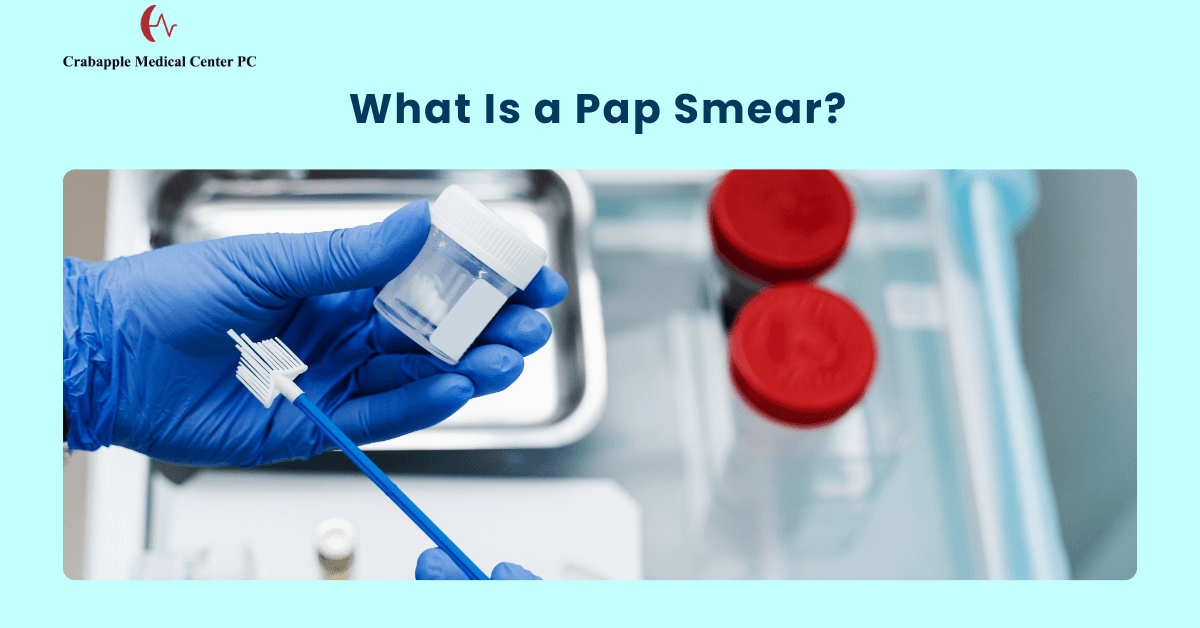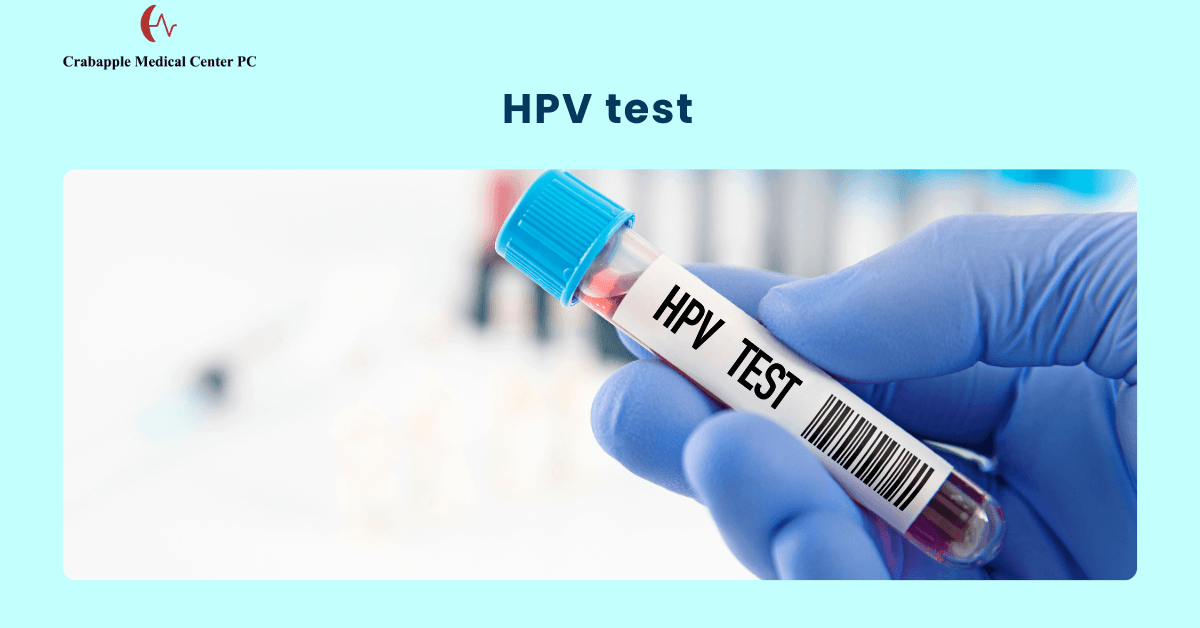Cervical cancer remains one of the most preventable yet still common cancers affecting women worldwide. Thanks to screening tools like the Pap smear (also called Pap test), many lives are saved every year through early detection.
At Crab Apple Medical, we believe in empowering women with information and access to preventive healthcare so that cervical cancer becomes rare, not a fear. This blog explains what Pap smears are, how cervical cancer develops, why early detection matters, what the guidelines are, and how Crab Apple Medical Center can support women in this journey.
What is Cervical Cancer?
Cervical cancer arises from uncontrolled growth of abnormal cells in the cervix; the lower part of the uterus that connects to the vagina.
Causes
The primary cause is persistent infection with high-risk types of human papillomavirus (HPV). Not all HPV infections lead to cancer, but certain strains (like HPV-16, HPV-18) are known to be high-risk. Other risk factors include smoking, weakened immunity, early sexual activity, multiple sexual partners, and lack of regular screening.
Progression
Cervical cancer usually develops slowly. Precancerous changes in the cervical cells can exist for years before turning into cancer. These early, non-cancerous changes are sometimes called dysplasia or CIN (Cervical Intraepithelial Neoplasia). If these are detected and treated early, progression to invasive cancer can often be prevented.

What is a Pap Smear?
A Pap smear (or Pap test) is a screening procedure where cells are gently scraped from the cervix and examined under a microscope to detect abnormalities.
Purpose:
It isn’t just about finding cancer. The test aims to find precancerous cell changes, ones that have not yet become cancer but may if left untreated.
How it’s done:
During a pelvic exam, a speculum is inserted to view the cervix. A brush or spatula (or a cytobrush) collects cells from the surface of the cervix and the transformation zone (where cancer often begins). These cells are preserved and sent to a lab. The process is quick and normally causes only mild discomfort.
What is the HPV Test, and How Does it Relate to the Pap Smear?

HPV Test
This test checks for the presence of high-risk HPV types in cervical cells. Since HPV infection is the main cause of cervical cancer, detecting HPV helps to assess risk.
Co-Testing
Many guidelines now recommend doing Pap test + HPV test together (co-testing), especially for certain age groups. This increases the sensitivity of screening (i.e. the ability to detect precancerous changes or early cancer).
Why Early Detection Matters
1. High Chance of Cure if Found Early
Cervical cancer detected at an early stage (before it spreads) is much more treatable and has excellent survival rates. Early intervention often requires less aggressive treatment and leads to better quality of life.
2. Preventing Cancer Rather than Just Treating it
Since precancerous changes can be identified and treated before they become cancer, screening allows prevention. Removing dysplastic cells early prevents the progression to invasive disease.
3. Reducing Morbidity and Mortality
With regular screening, many cases of cervical cancer can be caught before symptoms occur. This reduces the need for radical surgery, more extensive treatments, and reduces death rates.
4. Cost Effectiveness
Treating advanced cervical cancer is more costly (both in financial terms and human impact) than monitoring and treating precancerous lesions. Regular Pap smears are relatively low-cost and can save money by preventing the need for expensive treatments down the line.
5. Psychological Benefit
Being proactive in health screening empowers women, reduces anxiety about the unknown, and improves awareness of one’s body and risks.
Who Should Get Screened & When?
Guidelines vary by country, but there is broad agreement on certain key points. Here are commonly accepted recommendations, which you may adapt according to your local healthcare standards:
| Age Group | What to Do |
| Under 21 years | Usually no screening, unless high risk (e.g. immunocompromised) (ACOG) |
| 21 – 29 years | Pap test alone every 3 years if previous results have been normal. Some guidelines may defer co-testing until later. (ACOG) |
| 30 – 65 years | Options include: co-testing (Pap + HPV) every 5 years, or Pap alone every 3 years if co-testing not available or appropriate. (ACOG) |
| Over 65 years | Can consider stopping screening if previous tests have been normal and no history of high-risk lesions; otherwise continue depending on risk factors. (ACOG) |
| High risk groups | More frequent screening if HIV positive, immunocompromised, prior history of cervical dysplasia or cancer, exposure to certain toxins etc. |
What if Your Test Is Abnormal?

Understanding Results
Not all abnormal results mean cancer. They may show mild, moderate, or severe dysplasia (precancerous changes). Many mild changes regress on their own.
Follow-Up Procedures
If the Pap or HPV tests show abnormal or high-risk findings, the next steps may include a repeat test, more frequent monitoring, colposcopy (magnified examination), and possibly biopsy.
Treatment of Precancerous Changes
Depending on severity, treatment may include removal of abnormal tissue (e.g. LEEP, conization) to prevent progression. Early treatment improves outcomes significantly.
Compassionate Treatment & Follow-Up at Crab Apple Medical Center
If your Pap smear or HPV test shows an abnormal result, our experienced team provides comprehensive follow-up care; from colposcopy and biopsies to treatment of precancerous changes. We’ll guide you through every step with sensitivity and expertise, ensuring you get the right care at the right time.
Barriers to Screening & How to Overcome Them
Even though screening is effective, many women don’t undergo Pap smears regularly. Some barriers include:
- Lack of Awareness : Many women don’t know what cervical cancer is, or how screening works.
- Cultural or Social Stigma : Fear, embarrassment, concerns about confidentiality.
- Accessibility : Lack of clinics, cost of tests, poor transportation.
- Misconceptions : Beliefs that if you feel fine you don’t need a test; that Pap smears are painful; that they’re only for married women; etc.
How to Overcome:
- Education campaigns (community, media, NGOs).
- Making screening more accessible — mobile clinics, outreach programs, lower cost or subsidized tests.
- Ensuring female healthcare providers where culturally appropriate.
- Clear, compassionate communication about what test involves, why it matters, what the results mean.
Current Guidelines & Best Practices
Here are up-to-date practices, based on authorities like CDC, ACOG, WHO etc.:
- Start Screening at age 21.
- For ages 21-29 : Pap test every 3 years if no abnormal history.
- Ages 30-65 : Options include co-testing (Pap + HPV) every 5 years, or Pap alone every 3 years. Some guidelines accept primary HPV testing in suitable populations.
- After age 65 : If prior screening has been adequate and no abnormal history, screening may be discontinued. But this must be individualized.
- If High Risk (for example, HIV, immunocompromised, prior high-grade lesions) : more frequent or earlier screening.
Global & Local Picture
- Worldwide, cervical cancer is among the leading causes of cancer deaths in women, especially in low- and middle-income countries where screening programs are less established.
- Studies show that in areas without regular screening, incidence and mortality are significantly higher.
What Crab Apple Offers & How We Can Help?
At Crab Apple Medical Center, our mission is to make preventive women’s health services accessible, respectful, and effective. Here’s how we support cervical cancer prevention:
- Screening Services : We provide Pap smear and HPV testing in a comfortable, confidential setting.
- Patient Education : Workshops, counselling, printed materials (and online resources) on what to expect, how to prepare, why screening frequency matters etc.
- Follow-Up Care : For abnormal results, we coordinate colposcopy, biopsies, and referrals to specialists.
- Affordable Options : Subsidized or sliding-scale prices, special programs for underserved communities.
- Cultural Sensitivity : Female staff for those who prefer; respecting privacy; creating a non-judgmental environment.
- Awareness Campaigns : Partnerships with local organizations, social media outreach to reduce stigma, raise awareness.
What You Should Know & Do Today?
- If you are a woman aged 21 or more, check when you last had a Pap smear. If it has been more than 3 years (or 5 years if doing co-testing), make an appointment.
- Ask your healthcare provider whether HPV testing or co-testing is available and suitable for you.
- If you have any risk factors (HIV, weakened immune system, history of abnormal cell changes, early sexual activity, multiple partners), let your provider know. You may need more frequent monitoring.
- Don’t delay follow-ups of abnormal results — early action makes a big difference.
- If you’re unsure or fearful, ask questions: What happens during the test? Will it hurt? How long will results take? What will happen if something is abnormal?
| Myth | Fact |
| “I don’t need a Pap smear if I have no symptoms.” | Many cervical cancers and precancerous changes show no symptoms until they are advanced. Regular screening is key. |
| “Pap smear is very painful.” | Most people feel mild discomfort or pressure; the procedure is quick and safe. A trusted healthcare provider can help make you comfortable. |
| “Only married women or those who have had many partners get cervical cancer.” | HPV can be transmitted even in early sexual encounters. Risk is not only about number of partners; other factors matter too. |
| “If I get vaccinated against HPV, I don’t need Pap smears.” | HPV vaccines protect against most high-risk types but not all. Even vaccinated women should follow screening guidelines. |
Statistics & Impact
- According to global data, regular Pap smear screening has dramatically reduced cervical cancer incidence in many high-income countries since its adoption.
- Studies show that Pap smear screening is “a very useful, simple, economical, and safe tool for detecting precancerous cervical epithelial lesions.”
- Mortality rates drop significantly in areas with organized screening programs.
Possible Risks & Limitations
- False Negatives / False Positives : No test is perfect. Sometimes abnormal cells are missed, or benign changes are flagged. That’s why regular repeat testing is essential.
- Overdiagnosis / Overtreatment : Some mild abnormalities may regress on their own. Unnecessary treatment can lead to complications. That’s why guidelines are designed to balance detecting serious risk versus avoiding unnecessary interventions.
- Access and Quality Issues: Laboratories must be reliable; collecting good samples is important; delays in follow‐up can reduce benefits.
“Pap Smear” Process: What to Expect
Preparing for the Test
- Avoid intercourse, vaginal medications or douching 48 hours before the test.
- Schedule when you are not menstruating if possible, or at least after heavy flow.
- Wear comfortable clothing; plan some time after the test.
During the Test
- You lie on an exam table, knees apart, feet in stirrups.
- A speculum is inserted to gently open the vaginal walls.
- The provider collects cells from the cervix using a brush or spatula. It takes a few moments.
After the Test
- You may have light spotting or mild cramping; this is normal.
- The sample goes to a lab. Results usually take from a few days to a couple of weeks depending on lab and location.
If Results are Normal
- Follow the screening intervals as per guidelines.
If Results are Abnormal
- Your provider will advise follow-ups (repeat testing, colposcopy, biopsy, treatment as needed).
Preventive Care & Personal Empowerment: Our Promise to You
Early detection via Pap smears (and HPV testing/co-testing) can make the difference between a treatable precancerous condition and late-stage cervical cancer. By following screening guidelines, reducing stigma, improving awareness, and making services accessible, we can make cervical cancer a rare event.
At Crab Apple Medical Center, we are committed to ensuring every woman has the knowledge, access, and support to make informed decisions about her health. Because prevention is not just about medicine, it’s about empowerment.
Protect Your Health With Regular Screening
Early detection saves lives. Book your Pap smear and HPV screening at Crab Apple Medical Center in a safe, private and supportive environment. Our women’s health team is here to help you stay ahead of cervical cancer.
Frequently Asked Questions
What is a Pap Smear and Why is it Important?
A Pap smear is a quick test that checks for abnormal cells on the cervix. Detecting these changes early can prevent cervical cancer or catch it at its most treatable stage.
How often should I get a Pap smear?
Most women aged 21–29 need a Pap test every 3 years. From age 30–65, you can do a Pap test every 3 years or co-testing (Pap + HPV) every 5 years. Your healthcare provider at Crab Apple Medical Center will advise the best schedule for you.
Does a Pap smear Hurt?
The test is usually painless and takes just a few minutes. You may feel mild pressure or discomfort but not pain. Our team creates a calm, respectful environment to help you feel at ease.
I’ve Had the HPV Vaccine. Do I still Need Screening?
Yes. The HPV vaccine protects against most high-risk HPV types but not all. You should continue regular Pap smears according to guidelines.
What Happens if my Pap Smear Results are Abnormal?
An abnormal result doesn’t mean you have cancer. It often means further testing is needed, such as a repeat Pap test, an HPV test, or a colposcopy. Crab Apple Medical Center offers full follow-up care and counselling.

